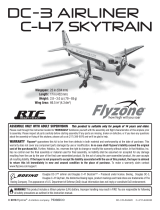
3
PRECAUTIONS
Your Eraze should not be considered a toy, but rather a
sophisticated, working model that functions very much like a
full-size airplane. Because of its performance capabilities, the
Eraze, if not assembled and operated correctly, could possibly
cause injury to yourself or spectators and damage to property.
1. Operate the plane according to the instructions. DO NOT
alter or modify the model. If you make any modifi cations,
you void your warranty.
2. Test the operation of the model before each fl ight to
ensure that all equipment is operating properly and that
the model remains structurally sound.
3. Fly only on calmer days (with wind speeds no more than
10 mph) and in large open areas free of trees, people,
buildings, or any other obstacles.
4. If you are not an experienced pilot or have not fl own this
type of model before, we recommend that you get the
assistance of an experienced pilot in your R/C club for
your fi rst fl ights. If you’re not a member of a club, your
local hobby shop has information about clubs in your area
whose membership includes experienced pilots. You can
also contact the National Academy of Model Aeronautics
(AMA) which has over 2,500 chartered clubs across the
country. Instructor training programs and insured newcomer
training are available through any of these clubs. Contact
the AMA at the following address or toll-free phone number:
Academy of Model Aeronautics
5151 East Memorial Drive Ph. (800) 435-9262
Muncie, IN 47302-9252 Fx. (765) 741-0057
www.modelaircraft.org
TRANSMITTER CAUTIONS
● Do not use rechargeable (NiCd) batteries.
● Do not mix old and new batteries.
● Do not mix alkaline, standard (carbon-zinc) or
rechargeable (NiCd) batteries.
BATTERY CHARGING PRECAUTIONS
❏ 1. Always remove the battery from your Eraze before
charging.
❏ 2. Allow the battery to cool after fl ight before recharging.
❏ 3. Do not leave a charging battery unattended! Unplug
the battery if it gets warm, even if the charge LED has not
gone out.
WARNING: Misuse or malfunction may overheat the battery
and charger, resulting in personal injury or damage to
surroundings.
It is critically important to use only 2S 7.4V or
3S 11.1V LiPo batteries within the recommended
capacity range that do not include a PCM (Protection
Circuit Module) charging circuit inside the battery.
Most PCM circuits restrict the delivery of power to the
ESC and motor and may cut all power to the receiver and
thus, result in complete loss of control over the model.
LITHIUM POLYMER BATTERY RECYCLING
ATTENTION: The product you have purchased
is powered by a rechargeable battery. At the end
of the battery’s useful life, under various state
and local laws, it may be illegal to dispose of this
battery into the municipal waste system. Check
with your local solid waste offi cials for details in your area
about recycling options or proper disposal.
WARNING: This product contains a chemical known to
the State of California to cause cancer.
ADDITIONAL ITEMS REQUIRED
Radio Control System
The Eraze Tx-R Prime (transmitter ready) comes with the
servos and a Tactic
™
TR624 receiver installed, so all that is
required is a 3
+
channel transmitter with elevon mixing. The
Tactic TTX404 2.4GHz spread spectrum 4-channel radio
control system (TACJ2404) is included with the RTF (ready
to fl y) version of the Eraze, so this same radio system is ideal
for your Tx-R version, too.
❍
Tactic TTX404 2.4GHz 4-channel system (TACJ2404)
❍
(4) AA batteries will be required to operate the
recommended transmitter (FUGP7300).
If you already own a transmitter that you plan to use with the
Eraze, fi rst make sure it is in the compatibility list at www.
Tx-Ready.com/anylink-chart.html. If so, you can purchase
the AnyLink
™
2.4GHz Universal Radio Adapter to allow your
transmitter to communicate with the pre-installed Tactic receiver.
❍ Tactic AnyLink 2.4GHz Universal Radio Adapter
(TACJ2000) which includes the AnyLink Cable
Futaba
®
Square (TACM0001) and the AnyLink Cable
JR/Spektrum/Graupner (TACM0002)
❍ Tactic AnyLink SLT
™
2.4GHz Adapter Cable Futaba
Hitec
®
Round (TACM0003)
❍ Tactic AnyLink SLT 2.4GHz Adapter Cable Hitec
Aurora (TACM0004)
❍ Tactic AnyLink SLT 2.4GHz Cable Spektrum
®
DX4e/5e/7s/8 (TACM0005)
❍ Tactic AnyLink SLT Cable Fut 12Z/14MZ/18MZ/4YF
2.4GHz (TACM0007)
❍ Tactic AnyLink SLT 2.4GHz Cable Spektrum
®
DX4e/5e/7s/8 Deans
®
Micro (TACM0008)


















